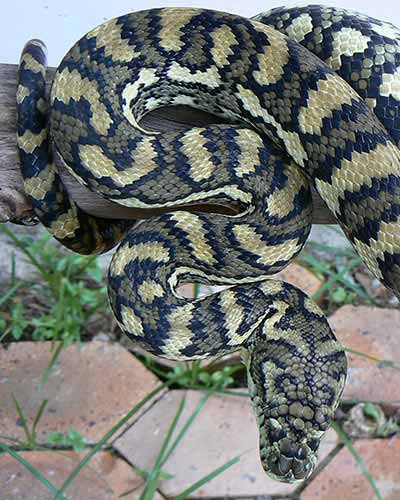Coastal Carpet Python
Snakes of South East Queensland
Coastal Carpet Python
Morelia spilota sub sp. mcdowelli
Other common names: Coastal Carpet Python, Carpet Snake

Species Profile
Significance to Humans:
Non Venomous
Bites from a large Carpet Python may cause substantial lacerations or punctures to both people or pets. Injuries can be quite severe. Bites requiring surgical intervention in both humans and pets have been recorded. In this case bites from this species should be avoided as a precaution.
General description: Large, heavy bodied snake with a highly variable, mottled & blotched pattern and colour. Mostly white to cream on the underside. Head is distinct from the neck. Deeply pitted scales (infralabials) along bottom jaw and to a lesser extent the upper jaw (supralabials) with small “granular scattered scales on top of the head. Midbody scales in 40 – 60 rows.
Average Length: Around 2.1 metres but large specimens exceed 3 meters. Largest reliable record at 4.2 metres in length. Tales of specimens spanning double lanes of standard road carriageways are greatly exaggerated and not substantiated by species records.
Habitat in SE Qld: Occupies all habitats from rainforest, wet sclerophyll forests and dry woodland through to suburban backyards and the periphery of highly disturbed farmland. Even commonly present in high density living areas.
General habits: Most commonly encountered snake within the region. Active day and night. Large specimens can take small suburban pets such as dogs, cats and guinea pigs with smaller specimens taking caged birds. This is one species that has thrived with habitat alteration and has been highly successful at proliferating within the suburban landscape.
Diet: Mostly mammals such as rodents, possums etc; also some reptiles, birds & frogs. Unfortunately for pet owners the Carpet Python readily predates on caged birds, domestic cats and dogs, guinea pigs and chickens.
Local distribution: Recorded from all suburbs of the Greater Brisbane region including the inner city with highest densities occurring in leafy suburbs such as The Gap, Chapel Hill, Kenmore and Holland Park, Daisy Hill. One of the more common species found within the confines of the Brisbane CBD district.
Around the home: Will utilise all above ground environs such as roof and wall cavities, exposed beams of verandahs and pergolas, sheds and garages. Often resides in the heavy foliage of trees and shrubs. At ground level will utilise dense vegetation, miscellaneous large ground litter such as stored building materials and accumulated garden debris. Any enclosures purpose built for housing family pets should be built with the intention of being snake proof.
Photo Gallery
Please be patient while our image gallery loads. If viewing images in the lightbox viewer by clicking on an image, please allow a few second between each image as some images are large to retain their quality and size. Images are loaded straight from Google Photos, if blank spaces appear in gallery please refresh your page.
All image are the property of the website or respected owner and can not be re-used without permission. Copyright applies
Photo ID 
Did you know WildlifeQld offers a snake & Lizard identification service. For our identification service simply use the upload form on www.snakecatchers.com.au We provide our Australian snake identification service free of charge and always welcome high quality images for potential inclusion on our website. This service is not just for Queensland snake identification but for all snake id across Australia.
The content on this page is intended only to provide a summary and general overview . It is not intended to be comprehensive nor does it constitute to be exact in every circumstances. We attempt to ensure that the Content is current but we do not guarantee its currency.
